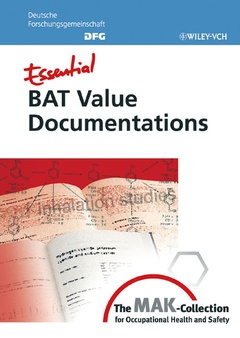Description
Essential BAT value documentations : from the MAK : Collection for occupational health & safety
Author: DREXLER Hans
Language: English
Subjects for Essential BAT value documentations : from the MAK...:
Approximative price 158.77 €
Subject to availability at the publisher.
Add to cart
Publication date: 03-2006
400 p. · 17x24 cm · Hardback
400 p. · 17x24 cm · Hardback
Description
/li>Contents
/li>
For more than 20 of the most important occupational toxicants, the documentations for the established BAT values (Biological Exposure Values) and EKA values (Exposure Equivalents for Carcinogenic Substances) are provided. These include an authoritative review of the available toxicological studies and data. For every substance, metabolism and pharmacokinetics, critical toxicity, exposure and effects, suitable indicators of internal exposure, the evaluation of the BAT value and the correct interpretation of data are described. Basic physico-chemical data are provided as well. The documentations are thus not only essential for the application of BAT and EKA values but provide a concise overview of biological monitoring for each substance. The documentations are authoritative, because they were compiled by the Commission for the Investigation of Health Hazards of Chemical Compounds in the Work Area. The Commission is internationally acknowledged for its neutrality and is working strictly according to transparent, scientific criteria. BAT Values set the standards for legal regulations in many countries of the world, e. g. they are the basis for at least 30 % of the threshold limits valid in the European Union.
GENERAL ASPECTS. Concept of BAT-values. Concept of BLW-values. Concept of EKA. SUBSTANCES. Acetone. Alkali chromates. Aniline. Arsenic and inorganic arsenic compounds. Arsenic trioxide. Benzene. Butanone (2-Butanone). Cobalt. Cresol (ortho). Cyclohexane. Diaminodiphenyl methane. Dimethyl sulfate. Ethylene glycol monobutyl ether. Ethylene oxide. Hydrogen fluoride. Lead and its inorganic compounds (inhalable fraction) except lead arsenate and lead chromate. Methanol. Nickel and nickel compounds. Propanol (2-Propanol). Styrene. Tetrachloro ethylene. Vinyl chloride. Xylene (all isomers).
© 2024 LAVOISIER S.A.S.




